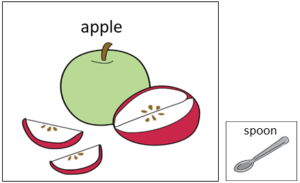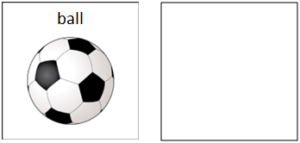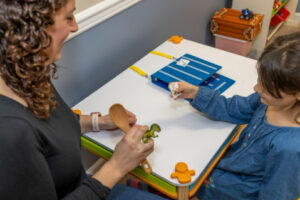TIPS FOR TEACHING PHASE IIIA OF THE PECS PROTOCOL
PICTURING POSSIBILITIES: PICTURE DISCRIMINATION WITHIN THE PICTURE EXCHANGE COMMUNICATION SYSTEM
PECS users sometimes have difficulty with Phase IIIA of the PECS protocol, Picture Discrimination. Pyramid Consultant, Anne Overcash, MEd, describes the journey of a PECS user’s difficulty with learning picture discrimination and how her educational team was able to support and teach these important skills.
When working on PECS Phase IIIA, Picture Discrimination, PECS users often fit into one of these categories:
- PECS users who know pictures prior to beginning PECS. Woohoo! This is great. Further assess picture knowledge by implementing Phases IIIA and IIIB. Best to assess, not guess!
- PECS users who learn the meaning of each picture in Phase III as good teaching is applied in 2 important and specific ways –first, when we acknowledge their accurate choice, “Ooooh the new” precisely when they choose the correct picture in Phase IIIA, and second, by applying appropriate error correction (yes, the EC procedure provides an opportunity to teach!).
- PECS users who struggle and do not rapidly meet the accuracy criterion (90% or greater) in Phase IIIA. This is where our teaching skills and patience may be tested, as this process can take time.

Many of these are described in the PECS Training Manual:
- Increased distance between the two pictures (pictures removed from PECS book to a large tabletop)
- Preferred vs. blank card
- Both pictures bigger (4 inches x 4 inches)
- Big preferred picture and small non-preferred picture

- Linear arrangement of pictures and items
- Colour photographs
With each change, the team continued to check their implementation skills and created many learning opportunities each day. They were aware that prolonged challenges within Phase IIIA could result in Batya not wanting to participate in these kinds of lessons, so they also arranged for PECS opportunities at either Phase I or II at various times across each day. This provided Batya with opportunities to practice existing PECS skills.
We discussed this challenge on a weekly basis and were open to additional strategies. Several team members were certain that moving to photographs would be the key, however, when this change was made, Batya’s accuracy remained the same, chance!

THE EUREKA MOMENT!
About a week into the use of coloured photographs, Batya’s Mom set out to make additional copies of the photographs on a copier at the family’s place of worship. Upon arrival, she was informed that they had run out of coloured ink for the printer (coloured ink was not as common as it is today!). Not wanting to wait, she made black and white copies of the pictures to have ready when needed. Several days went by and the classroom team grabbed some of the black and white spare pictures to utilize during an art activity. They were surprised and elated when Batya made correct selections several times in a row and when they calculated, her accuracy was very near 100% within that activity. Remember, her accuracy within Phase III hovered around 50% prior to this day! This was noted in the home/school notebook; however, no one thought to describe the use of black and white photographs. They thought perhaps the art activity was super motivating.
DIGGING DEEPER
Several days and more data collection later revealed a few activities with very high accuracy and others at or near 50%; they began looking more carefully and documenting additional details about the lesson, who was teaching, which two photographs, and noting if both were colour, both were black and white, or one of each since they realized that the photos within Batya’s communication binder were a mixture. A clear pattern emerged: when both were black and white, accuracy was nearly 100%. Phase IIIB was introduced with all black and white photos, Batya’s accuracy remained extremely high. At this point, Batya once again made rapid progress through the next PECS Phases! Over the next several weeks the team gradually reduced the size of these pictures which started out as 4 x 6 inches (standard photo size) to something close to 2 x 3 inches.
DEDICATION
With a steady gaze toward the goal of helping Batya be a more accurate and thus more effective communicator, this team continued to teach, observe, collect data, and ultimately try a different approach until Batya was successful. Take home message—be persistent, your diligence will help this person be a more effective communicator and could be life-changing for them as they are able to more accurately communicate with those around them.
Thank you for joining me as I recounted this journey of discovery to determine how Batya sees her world as a PECS user and successful communicator. Ever mindful that 1990 may seem like a long time ago, these teaching strategies are just as relevant today as they were 30 years ago. In the end, good teaching is good teaching. While your learners may require different strategies, the process will likely be very much the same.
Ready for a deeper dive into this topic? Stay tuned for Jo-Anne Matteo and my presentation in a new online course titled: Teaching Picture Discrimination: A Deeper Dive, coming soon on the Pyramid Online Learning portal! After you check it out, let us know if you have additional picture discrimination strategies that have worked for your learners. We can all use many different tools and strategies in our teaching tool kits. We will enjoy reading about and sharing yours too!
Written by Anne Overcash, MEd
© Pyramid Educational Consultants, LLC. 2023
